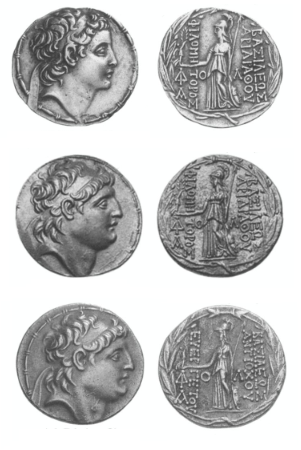S 508 - Eusebeia (Cappadocian kings), silver, tetradrachms (104-102 BCE)
From SILVER
104 BCE - 102 BCE Silver 12,877 kg
Description
| ObverseInscription or printing placed on the obverse.: | Diademed head of Ariarathes VII right, fillet border (issue 1) or Diademed head of Antiochus VII right, fillet border (issues 2-3). |
| ReverseInscription or printing placed on the reverse.: | ΒΑΣΙΛΕΩΣ ΑΡΙΑΡΑΘΟΥ ΦΙΛΟΜΗΤΟΡΟΣ (issues 1-2) ou ΒΑΣΙΛΕΩΣ ΑΝΤΙΟΧΟΥ ΕΥΕΡΓΕΤΟΥ (issue 3) (Greek).ΒΑΣΙΛΕΩΣ ΑΡΙΑΡΑΘΟΥ on right, ΦΙΛΟΜΗΤΟΡΟΣ on left (issues 1-2), ΒΑΣΙΛΕΩΣ ΑΝΤΙΟΧΟΥ on right, ΕΥΕΡΓΕΤΟΥ on left (issue 3). In all issues : Athena standing left., resting hand on grounded shield and holding Nike who faces right., crowning royal epithet, spear in crook of Athena's arm, laurel wreath border. |
Mint and issuing power
| MintIdentifies the place of manufacture or issue of a numismatic object.: | Eusebeia | Ancient regionAncient region.: | Cappadocia | Modern countryModern country: Turkey | AuthorityIdentifies the issuing power. The authority can be "pretended" when the name or the portrait of X is on the coin but he/she was not the issuing power. It can also be "uncertain" when there is no mention of X on the coin but he/she was the issuing power according to the historical sources: | Antiochus VII Euergetes (Seleucid king, 138-129 BC), Ariarathes VII Philometor (king of Cappadocia, c. 116-c. 100 BC) |
Chronology
| FromIdentifies the initial date in a range assigned in a numismatic context. | 104 BCE | toIdentifies the final date in a range assigned in a numismatic context.. | 102 BCE | PeriodTime period of the numismatic object.: Hellenistic 323-30 BC |
Physical description
| MetalThe physical material (usually metal) from which an object is made.: | Silver |
Median weightMedian of the weights of numismatic objects (in grams). in grams | 16.50 | DenominationTerm indicating the value of a numismatic object. Examples: tetradrachm, chalkous, denarius.: | tetradrachm |
StandardStandard.: | Attic |
References
| Die study referencePublication of the study: | Lorber - Houghton - Veselý 20061Lorber - Houghton - Veselý 2006, p. 65-75 (série 1). | ||
| Coin series referenceReference to coin series study: | |||
| Coin series web referenceCoin series web references: | |||
Obverse dies distribution
| FrequencyFrequency of specimen in distribution. ᵖ | Number of obversesNumber of obverse dies. ᵖ (o) | % (o) | Number of coinsNumber of coins. (n) | % (n) | Die nameName(s) of the die(s). |
| 1 | 13 | 34.21 | 13 | 3.86 | |
| 2 | 2 | 5.26 | 4 | 1.19 | |
| 3 | 3 | 7.89 | 9 | 2.67 | |
| 4 | 1 | 2.63 | 4 | 1.19 | |
| 5 | 2 | 5.26 | 10 | 2.97 | |
| 6 | 1 | 2.63 | 6 | 1.78 | |
| 7 | 2 | 5.26 | 14 | 4.15 | |
| 9 | 1 | 2.63 | 9 | 2.67 | |
| 10 | 2 | 5.26 | 20 | 5.93 | |
| 11 | 1 | 2.63 | 11 | 3.26 | |
| 13 | 2 | 5.26 | 26 | 7.72 | |
| 14 | 1 | 2.63 | 14 | 4.15 | |
| 16 | 1 | 2.63 | 16 | 4.75 | |
| 18 | 2 | 5.26 | 36 | 10.68 | |
| 29 | 1 | 2.63 | 29 | 8.61 | |
| 31 | 1 | 2.63 | 31 | 9.2 | |
| 35 | 1 | 2.63 | 35 | 10.39 | |
| 49 | 1 | 2.63 | 49 | 14.54 | |
| Total | 38 of 38 | 99.96 | 336 of 337 | 99.71 |
Reverse dies distribution
no distribution is available
Quantification
| Number of obversesNumber of obverse dies. ᵖ (o) | 38 | Number of singletons (o1)The number of singleton coins. ᵖ | 13 |
| Number of reverse diesNumber of reverse dies. (r) | Number of coinsNumber of coins. (n) | 337 | |
| Coins per obverse dieNumber of coins per obverse die. (n/o) | 8.87 | Coins per reverse dieNumber of coins per reverse die. (n/r) | |
| Reverse per obverse ratioRatio of obverse dies divided by reverse dies. (r/o) | Percentage of singletons (o1)number of coins (n) divided by the number of singletons (o1) ᵖ | 34.21 % | |
| Original number of dies (O) (Carter 1983 formula)The estimation of the number of coins according to Carter 1983 ᵖ | 39.02 | Coins struck if 20,000 as average productivity per dieCoins made if the average productivity for obverses (according to Carter) is 20,000. ᵖ | 780,400 |
| Original number of dies (O) (Esty 2011 formula)The estimation of the number of coins according to the singleton formula in Esty 2011 ᵖ (O) | 42.83 | Survival rate if 20,000 as average productivity per dieSurvival rate if average productivity is 20,000. ᵖ | 0.00043 |
| Coverage (o = % of O) (Esty 1984 formula)Esty 1984 - coverage (% of O) ᵖ (o = % of O) | 96.14% | Die productivity if survival rate 1/2,000Average productivity if survival rate is 1/2,000. ᵖ | 17,273.19 |
| Weight of silver (in kg) if 20,000 coins per die (O = Carter formula)Carter 1983 * Median weight * 20000 (*10 if gold or electrum) ᵖ | 12,877 kg <br /> 12,877 kg | Die productivity if survival rate 1/5,000Average productivity if survival rate is 1/5,000. ᵖ | 43,182.98 |
Remarks
Most likely one single workstation
References
- ^ Lorber, Catherine C. - Houghton, Arhtur - Veselý, Petr (2006), "Cappadocian Tetradrachms in the Name of Antiochus VII. With an Appendix of quantitative analyses by Peter Vesely", Numismatic Chronicle 166, p. 65-75 (série 1).
